
Centro: The Heart of Cartagena's Colonial Charm
Discover Centro, Cartagena: A blend of colonial history, vibrant culture, and culinary delights in the heart of Colombia's coastal gem.
Centro in Cartagena, Colombia, is a vibrant neighborhood that serves as the heartbeat of the city's colonial charm. As you walk through its cobbled streets, you'll find yourself surrounded by beautifully preserved Spanish colonial architecture, brightly colored buildings, and impressive churches. The historic significance of the area is palpable, with many structures dating back to the 16th century, offering a sense of timelessness that transports visitors back to a bygone era. A visit to Centro is incomplete without exploring its numerous plazas, each with its own unique character and history. Plaza Santo Domingo is particularly famous for its lively atmosphere, where street performers and musicians add to the charm, while Plaza de los Coches offers a glimpse into the city's past with its iconic clock tower, Torre del Reloj. The neighborhood is also home to the impressive Cartagena Cathedral and the Palace of the Inquisition, both of which are must-see landmarks. Centro is not just about history; it is also a hub for culture and cuisine. The area boasts a myriad of restaurants offering delicious Colombian dishes, as well as international fare. Don't miss the chance to try local specialties like arepas and ceviche. Additionally, the neighborhood is dotted with boutique shops and art galleries, perfect for picking up unique souvenirs or simply enjoying the local creative scene. One of the highlights of visiting Centro is the opportunity to experience its vibrant nightlife. From rooftop bars offering stunning views of the city to lively salsa clubs where you can dance the night away, there's something for everyone. The neighborhood truly comes alive after dark, making it an essential part of any Cartagena itinerary.
Local tips in Centro
- Visit early in the morning or late in the afternoon to avoid the midday heat and crowds.
- Wear comfortable shoes as you'll be walking on cobblestone streets.
- Carry a small amount of cash for street vendors and tips.
- Take a guided walking tour to fully appreciate the historical significance of the area.
- Don't forget to try local fruits from street vendors; they are fresh and delicious.
Centro: The Heart of Cartagena's Colonial Charm
Centro in Cartagena, Colombia, is a vibrant neighborhood that serves as the heartbeat of the city's colonial charm. As you walk through its cobbled streets, you'll find yourself surrounded by beautifully preserved Spanish colonial architecture, brightly colored buildings, and impressive churches. The historic significance of the area is palpable, with many structures dating back to the 16th century, offering a sense of timelessness that transports visitors back to a bygone era. A visit to Centro is incomplete without exploring its numerous plazas, each with its own unique character and history. Plaza Santo Domingo is particularly famous for its lively atmosphere, where street performers and musicians add to the charm, while Plaza de los Coches offers a glimpse into the city's past with its iconic clock tower, Torre del Reloj. The neighborhood is also home to the impressive Cartagena Cathedral and the Palace of the Inquisition, both of which are must-see landmarks. Centro is not just about history; it is also a hub for culture and cuisine. The area boasts a myriad of restaurants offering delicious Colombian dishes, as well as international fare. Don't miss the chance to try local specialties like arepas and ceviche. Additionally, the neighborhood is dotted with boutique shops and art galleries, perfect for picking up unique souvenirs or simply enjoying the local creative scene. One of the highlights of visiting Centro is the opportunity to experience its vibrant nightlife. From rooftop bars offering stunning views of the city to lively salsa clubs where you can dance the night away, there's something for everyone. The neighborhood truly comes alive after dark, making it an essential part of any Cartagena itinerary.
Iconic landmarks you can’t miss
Monumento Torre del Reloj
Explore the stunning Torre del Reloj in Cartagena, a historic landmark that beautifully captures the essence of Colombia's rich heritage and vibrant culture.

Plaza de Santa Teresa
Explore Plaza de Santa Teresa: A vibrant cultural hub in Cartagena filled with history, stunning architecture, and local gastronomy.

Plaza de la Aduana
Discover the vibrant Plaza de la Aduana, a cultural landmark in Cartagena filled with history, stunning architecture, and local delights.

Plaza San Pedro Claver
Explore the vibrant Plaza San Pedro Claver, a historical gem in Cartagena filled with culture, stunning architecture, and local charm.
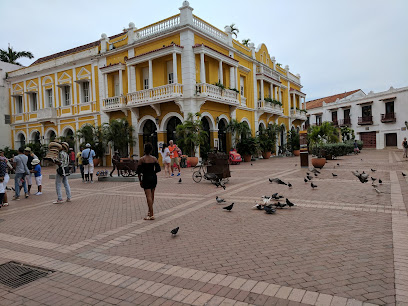
Baluarte de Santo Domingo
Explore Baluarte de Santo Domingo, a historical fortress in Cartagena offering stunning views, rich history, and a vibrant cultural experience.

Palacio de la Proclamación
Explore the rich history and vibrant culture at the Palacio de la Proclamación, a must-see historical landmark in Cartagena, Colombia.

Centro Histórico de Cartagena
Explore the vibrant history and culture of Centro Histórico de Cartagena, a UNESCO World Heritage site with stunning colonial architecture and lively streets.
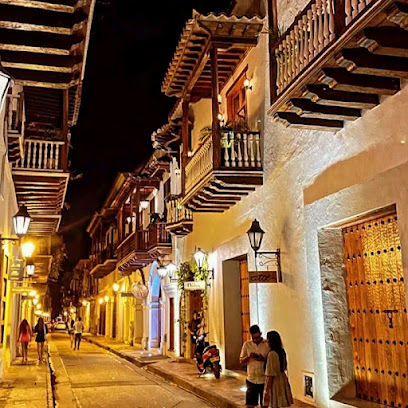
Camellón de los Mártires
Explore Camellón de los Mártires, a vibrant historical landmark in Cartagena, where culture, beauty, and rich history come together.

Sector Centro Histórico
Discover the charm of Cartagena's Sector Centro Histórico, where colorful colonial architecture meets vibrant local culture and history.

Plaza Pareja
Explore Plaza Pareja, Cartagena's vibrant historical landmark, where colonial charm meets lively culture and delicious local cuisine.

Unmissable attractions to see
Plaza de Santa Teresa
Explore the historic and lively Plaza de Santa Teresa in Cartagena, Colombia, where culture, architecture, and vibrant life intertwine.

Centro Histórico de Cartagena
Discover the vibrant heart of Cartagena, where colonial charm meets Caribbean culture in the historic Centro Histórico de Cartagena.

Museo De San Pedro Claver
Explore Museo De San Pedro Claver in Cartagena, a profound journey through the life of a Jesuit priest and the history of slavery in Colombia.

Essential places to dine
Restaurante San Valentin
Experience authentic Colombian flavors at Restaurante San Valentin in Cartagena - a culinary gem offering delightful dishes in a welcoming setting.

Restaurante Espiritu Santo
Experience authentic Colombian cuisine at Restaurante Espiritu Santo in Cartagena's vibrant El Centro district.

Buena Vida Marisquería - Cartagena
Experience Cartagena's vibrant seafood scene at Buena Vida Marisquería - where fresh flavors meet lively ambiance.

ALMA Restaurante - Bar
Experience the essence of Colombian cuisine at ALMA Restaurante - Bar in Cartagena—where tradition meets modern culinary artistry.

El Burlador Gastrobar
Experience exquisite Mediterranean and Spanish cuisine at El Burlador Gastrobar in Cartagena's vibrant heart.

La Catedral Restaurante
Experience authentic Colombian cuisine at La Catedral Restaurante in Cartagena - where flavor meets tradition in a charming setting.

Restaurante Donde Olano | Cartagena
Experience authentic Colombian cuisine at Restaurante Donde Olano in Cartagena's Historic Center - where tradition meets flavor.

PaloSanto Restaurante | Cartagena de Indias
Discover authentic Colombian cuisine at PaloSanto Restaurante in Cartagena - where fresh seafood meets vibrant flavors in a welcoming atmosphere.

Norma Restaurante
Discover authentic Italian and Mediterranean flavors at Norma Restaurante in Cartagena's historic center – a culinary experience not to be missed!

Luxury Restaurante
Discover gourmet dining at Luxury Restaurante in Cartagena – where exquisite flavors meet elegant surroundings for an unforgettable culinary experience.

Markets, malls and hidden boutiques
Mallplaza Cartagena - El Castillo
Explore the vibrant Mallplaza Cartagena - El Castillo, where shopping, dining, and entertainment converge in a modern oasis in the heart of Cartagena.
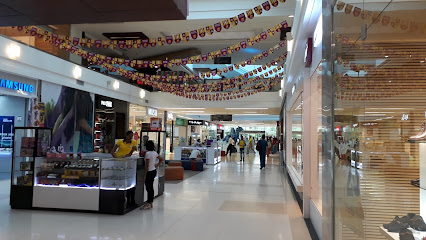
Ciudad Amurallada Cartagena
Discover the vibrant shopping and rich history of Ciudad Amurallada Cartagena, a must-visit destination for every traveler in Colombia.

Mansion Mall
Discover the vibrant shopping experience at Mansion Mall, Cartagena's top destination for fashion, dining, and local culture.

Pasaje La Moneda
Discover the cultural richness of Cartagena at Pasaje La Moneda, a shopping mall filled with local crafts, delicious snacks, and vibrant atmosphere.
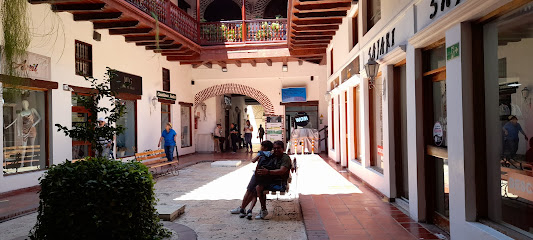
Casa Abba - Gallery-Boutique
Discover local artistry at Casa Abba, Cartagena's premier gallery-boutique showcasing vibrant crafts and unique artworks in a charming setting.

CHIQUI HOUSE BOUTIQUE
Explore Chiqui House Boutique - Your destination for unique, locally crafted treasures in the heart of Cartagena.

St. Dom Cartagena
Discover the vibrant spirit of Cartagena at St. Dom, a boutique showcasing local crafts and fashion in the heart of Colombia's historic district.

Silvia Tcherassi Cartagena
Discover the vibrant elegance of Silvia Tcherassi Boutique in Cartagena, where Colombian fashion meets Caribbean charm for an unforgettable shopping experience.

Salvatore Ferragamo
Explore the luxurious world of Salvatore Ferragamo in Cartagena, featuring exquisite leather goods, stylish shoes, and exceptional craftsmanship.
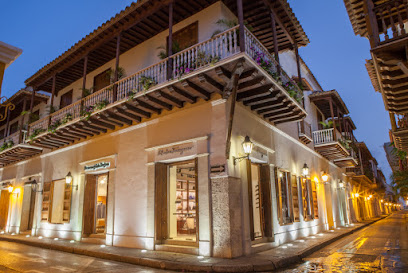
Aja Company
Discover the vibrant essence of Colombia at Aja Company, your go-to gift shop for unique souvenirs in Cartagena's historic heart.

Essential bars & hidden hideouts
Alquimico
Discover Alquimico, Cartagena's premier cocktail bar offering innovative drinks and a vibrant atmosphere, perfect for an unforgettable night out.

Bourbon St. Cartagena
Experience the vibrant flavors of Cartagena at Bourbon St., a lively grill restaurant serving up delicious culinary delights in a festive atmosphere.

The Clock Pub Cartagena
Discover the lively spirit of Cartagena at The Clock Pub, where delicious food meets vibrant entertainment in a cozy atmosphere.

El Barón
Experience the essence of Cartagena nightlife at El Barón, where innovative cocktails and delicious cuisine come together in a vibrant setting.

Bar Tu Candela
Discover the vibrant nightlife at Bar Tu Candela, where delicious cocktails and hearty fare await in the heart of Cartagena.

Mondo Cocktail Bar
Discover the art of mixology at Mondo Cocktail Bar, Cartagena's premier destination for craft cocktails and vibrant nightlife.

Monkey Bar
Discover the lively nightlife at Monkey Bar in Cartagena's historic center, where cocktails and local music create an unforgettable experience.

Barra 7 - Cocktail Bar
Discover the vibrant flavors of Cartagena at Barra 7, where creative cocktails and a lively atmosphere await you.

Vi Bar
Discover the vibrant atmosphere and exquisite cocktails at Vi Bar, situated in the heart of Cartagena's historic district, where culture meets nightlife.

Crazy place
Discover Crazy Place, a vibrant bar in the heart of Cartagena, where cocktails, music, and local culture blend for an unforgettable nightlife experience.

Local Phrases
-
- HelloHola
[oh-lah] - GoodbyeAdiós
[ah-dee-ohs] - YesSí
[see] - NoNo
[noh] - Please/You're welcomePor favor/De nada
[por fah-vohr/deh nah-dah] - Thank youGracias
[grah-see-ahs] - Excuse me/SorryPerdón/Lo siento
[pehr-dohn/loh see-en-toh] - How are you?¿Cómo estás?
[koh-moh ehs-tahs] - Fine. And you?Bien. ¿Y tú?
[bee-ehn. ee too] - Do you speak English?¿Hablas inglés?
[ah-blahs een-glays] - I don't understandNo entiendo
[noh ehn-tee-ehn-doh]
- HelloHola
-
- I'd like to see the menu, pleaseMe gustaría ver el menú, por favor
[meh goos-tah-ree-ah vehr ehl meh-noo, por fah-vohr] - I don't eat meatNo como carne
[noh koh-moh kahr-neh] - Cheers!¡Salud!
[sah-loohd] - I would like to pay, pleaseMe gustaría pagar, por favor
[meh goos-tah-ree-ah pah-gahr, por fah-vohr]
- I'd like to see the menu, pleaseMe gustaría ver el menú, por favor
-
- Help!¡Ayuda!
[ah-yoo-dah] - Go away!¡Vete!
[veh-teh] - Call the Police!¡Llama a la policía!
[yah-mah ah lah poh-lee-see-ah] - Call a doctor!¡Llama a un médico!
[yah-mah ah oon meh-dee-koh] - I'm lostEstoy perdido
[ehs-toy pehr-dee-doh] - I'm illEstoy enfermo
[ehs-toy ehn-fehr-moh]
- Help!¡Ayuda!
-
- I'd like to buy...Quisiera comprar...
[kee-see-eh-rah kohm-prahr] - I'm just lookingSolo estoy mirando
[soh-loh ehs-toy mee-rahn-doh] - How much is it?¿Cuánto cuesta?
[kwan-toh kwehs-tah] - That's too expensiveEso es muy caro
[eh-soh ehs moo-ee kah-roh] - Can you lower the price?¿Puedes bajar el precio?
[pweh-dehs bah-har ehl pree-syoh]
- I'd like to buy...Quisiera comprar...
-
- What time is it?¿Qué hora es?
[keh oh-rah ehs] - It's one o'clockEs la una
[ehs lah oo-nah] - Half past (10)Y media (10)
[ee meh-dee-ah (dheez)] - MorningMañana
[mah-nyah-nah] - AfternoonTarde
[tahr-deh] - EveningNoche
[noh-cheh] - YesterdayAyer
[ah-yehr] - TodayHoy
[oy] - TomorrowMañana
[mah-nyah-nah] - 1Uno
[oo-noh] - 2Dos
[dohs] - 3Tres
[trehs] - 4Cuatro
[kwah-troh] - 5Cinco
[seen-koh] - 6Seis
[sehs] - 7Siete
[see-eh-teh] - 8Ocho
[oh-choh] - 9Nueve
[nweh-veh] - 10Diez
[dyehs]
- What time is it?¿Qué hora es?
-
- Where's a/the...?¿Dónde está...?
[dohn-deh ehs-tah] - What's the address?¿Cuál es la dirección?
[kwal ehs lah dee-rehk-syohn] - Can you show me (on the map)?¿Puedes mostrarme (en el mapa)?
[pweh-dehs mohs-trar-meh (ehn ehl mah-pah)] - When's the next (bus)?¿Cuándo es el próximo (bus)?
[kwan-doh ehs ehl proh-ksee-moh (boos)] - A ticket (to ....)Un boleto (para ....)
[oon boh-leh-toh (pah-rah)]
- Where's a/the...?¿Dónde está...?
History of Centro
-
Centro in Cartagena was founded in 1533 by Spanish explorer Pedro de Heredia. The area quickly became a critical port for the Spanish Empire, facilitating trade and the export of valuable goods such as gold and emeralds. The strategic location of Cartagena allowed it to flourish as a key military and commercial hub in the Caribbean.
-
Constructed between 1536 and 1657, the Fortress of San Felipe de Barajas is one of the most significant military structures in the Americas. It was built to protect the city from pirate attacks and foreign invasions, reflecting the military importance of Centro during the colonial period. Its strategic design and massive walls exemplify the advanced military architecture of the time.
-
During the 17th and 18th centuries, Cartagena became a major hub for the transatlantic slave trade. The influx of enslaved Africans contributed to the cultural richness of Centro, leading to a unique blend of African, Indigenous, and Spanish influences. This cultural amalgamation is still evident today in the vibrant music, dance, and culinary traditions of Cartagena.
-
The early 19th century was marked by a struggle for independence from Spanish rule. Cartagena played a pivotal role in Colombia's fight for freedom, resulting in several battles and changes in governance. In 1821, Cartagena officially became part of the newly formed Republic of Gran Colombia, shaping its political landscape for years to come.
-
In 1959, Centro was declared a National Heritage Site of Colombia due to its well-preserved colonial architecture and historical significance. In 1984, it was designated a UNESCO World Heritage Site, attracting tourists from around the world. Efforts to preserve its historical buildings and cultural identity continue to this day, ensuring that the rich legacy of Centro remains intact.
Centro Essentials
-
Centro is easily accessible from other neighborhoods in Cartagena. From the airport, you can take a taxi or an airport shuttle service to reach Centro, which is approximately 15 minutes away by car. If you are coming from nearby neighborhoods like Getsemani or Bocagrande, you can walk, as they are within a 20-30 minute stroll. Alternatively, local buses and taxis are also available for a quick ride.
-
Centro is best explored on foot due to its compact size and pedestrian-friendly streets. Walking allows you to fully appreciate the historical architecture and vibrant street life. For longer distances, taxis are readily available, and you can use rideshare apps like Uber. Biking is another option, with bike rentals available at various locations. Public transport options are limited within Centro, so walking or taxis are the most convenient.
-
Centro is generally safe for tourists, especially during the day. However, it is advisable to avoid walking alone at night, particularly in less crowded areas. Be cautious around the outskirts of Centro, where petty crimes such as pickpocketing can occur. Specific areas to avoid include the outskirts near the San Diego neighborhood after dark. Always remain vigilant and keep your belongings secure.
-
In case of an emergency, dial 123 for police assistance or 125 for medical emergencies. The main hospital, Hospital Universitario del Caribe, is located within Centro. Keep a list of emergency contacts handy, including your country's embassy or consulate. It is highly recommended to have travel insurance that covers emergencies. Pharmacies are widely available for minor health issues.
-
Fashion: Do wear light, breathable clothing due to the tropical climate, but avoid overly revealing outfits, especially in religious sites. Religion: Do respect local customs; when visiting churches, wear appropriate attire. Public Transport: Do be polite and offer your seat to the elderly. Don’t eat or drink on public transport. Greetings: Do greet with a friendly smile and a handshake. Don't be overly formal; a casual approach is often welcomed. Eating & Drinking: Do try local street food and drink plenty of water. Don't drink tap water; always opt for bottled water.
-
To experience Centro like a local, explore the vibrant street markets where you can sample local delicacies such as arepas and empanadas. Engage in conversations with local vendors for insights into Cartagena’s culture. Visit the Plaza Santo Domingo in the evening for a lively atmosphere with street performers. Additionally, don’t miss the opportunity to take a sunset stroll along the city walls for stunning views of the Caribbean Sea.
-
When interacting with locals, it’s customary to greet with 'Hola' and a warm smile. Colombians appreciate friendliness and may engage in small talk. Be mindful of personal space, as Colombians are generally warm but may have varying comfort levels with closeness. When dining, it is polite to wait for everyone to be served before starting your meal, and always thank your host.
-
When in Centro, try local dishes like 'Bandeja Paisa' for a hearty meal or 'Ceviche' for a refreshing seafood option. Don't miss out on local fruits like 'Lulo' and 'Maracuyá' (passion fruit). Street vendors offer a variety of snacks, and it's common to see locals enjoying fresh juices. Always check food hygiene before purchasing from street vendors.
Nearby Cities to Centro
-
Things To Do in Barranquilla
-
Things To Do in Sincelejo
-
Things To Do in Santa Marta
-
Things To Do in Riohacha
-
Things To Do in San Blas Islands
-
Things To Do in Cúcuta
-
Things To Do in Portobelo
-
Things To Do in Panama City
-
Things To Do in Medellín
-
Things To Do in Colon
-
Things To Do in Tunja
-
Things To Do in Manizales
-
Things To Do in Las Tablas
-
Things To Do in Chitre
-
Things To Do in Pereira













